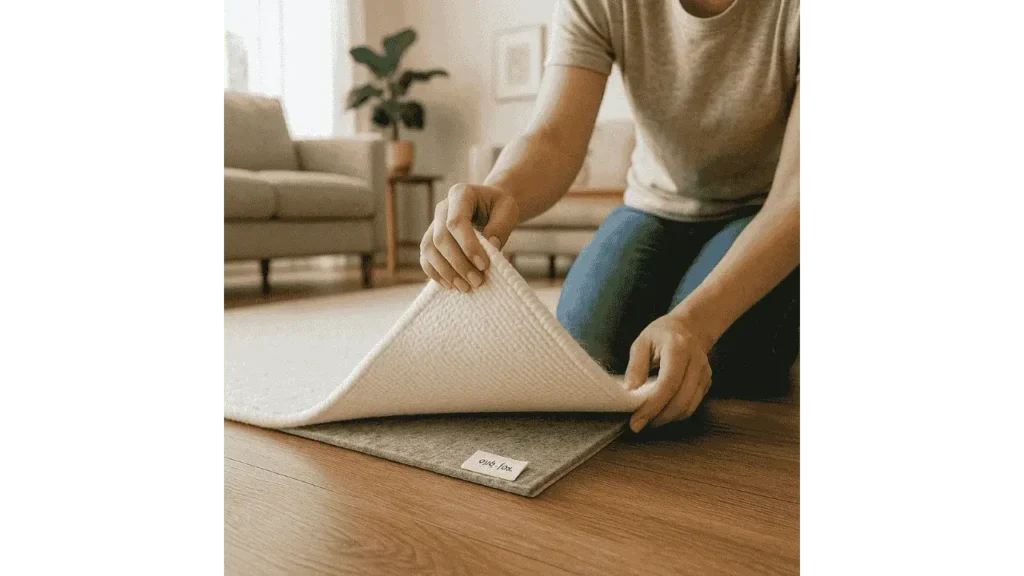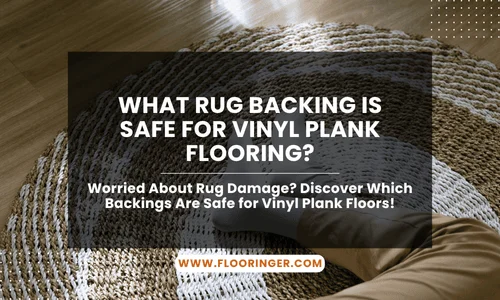The rug you place on top of your vinyl floor might seem harmless, but the backing material can have a lasting impact. Over the years, I’ve seen cases where the wrong rug left behind stains, warping, or even permanent discoloration. Choosing a rug with the right backing ensures your floors stay in excellent condition while adding comfort and style to your space.

Why Does the Rug’s Backing Material Really Matter?
The backing of a rug isn’t just about grip; it’s what sits directly on your floor all day, every day. Some materials, like PVC or synthetic latex, contain chemicals that react with vinyl flooring and cause yellowing or damage. Moisture buildup is another concern, especially under rugs that don’t breathe. When you choose a safe backing, you’re not just avoiding damage; you’re also extending the life and appearance of your vinyl floors. It’s a small detail that makes a big difference, especially in homes where rugs are used in busy areas.
Safe Rug Backings That Work Well with Vinyl Plank Flooring
As flooring specialist Linda Mayfield puts it,
“Natural materials like felt and real rubber create a safe buffer between the rug and vinyl, helping avoid damage that shows up months down the line.”
Natural Rubber: A top choice for vinyl, natural rubber grips well and won’t leave stains or sticky residue. Unlike synthetic rubber, it doesn’t leach harmful chemicals that can damage the flooring finish. It’s especially effective in high-traffic areas like entryways or kitchens where slipping can be a concern.
Felt: This soft, cushiony option creates a gentle barrier between rug and floor. It allows airflow and offers padding, ideal for larger rugs or rooms where comfort underfoot matters. Felt also minimizes pressure marks that sometimes appear when heavy furniture sits on top of area rugs.
Vinyl-Compatible Labels: Some rugs are clearly marked as safe for vinyl floors. These are made with materials tested to avoid chemical reactions and staining. Always look for that label if you’re unsure. It can save you the trouble of testing materials or dealing with unexpected floor damage.
Learn More: Which Way Should Vinyl Plank Flooring Run in a Hallway?
Rug Backings You Should Avoid at All Costs
PVC and Plastic: Often found in cheaper rugs, these materials can trap moisture and release chemicals that stain or warp vinyl flooring. Over time, you might notice cloudy patches or discoloration that doesn’t go away even with cleaning.
Synthetic Rubber: While it grips well at first, it tends to break down over time and can react with vinyl surfaces, leaving permanent marks or discoloration. It’s especially risky in warm environments where breakdown can happen faster.
Latex: Not all latex is created equal. Many latex backings include additives that can become sticky or degrade, especially with heat or prolonged use. Removing these rugs can sometimes peel up the floor’s finish or leave behind residue.
Tips to Keep Rugs from Damaging Your Vinyl Floors
According to interior design expert Calvin Rhodes,
“The damage most people worry about doesn’t happen overnight; it builds slowly when rugs are left unchecked on sensitive floors like vinyl.”
Stick to rug pads made of felt or natural rubber; these give you added grip and protection. Avoid using sticky pads or adhesives, as they can bond to the floor and leave marks. Also, clean both your rugs and floors regularly. A dirty rug can scratch vinyl, especially if grit or debris builds up beneath it. Rotating rugs can help prevent uneven fading or wear in areas exposed to sunlight. If you’re using rugs in moisture-prone spaces like bathrooms or kitchens, be extra cautious and lift them regularly to check underneath.
Final Takeaways
If you’ve invested in vinyl plank flooring, it makes sense to protect it properly. The wrong rug backing can quietly cause major damage over time. Stick with natural rubber, felt, or vinyl-safe rugs, and skip anything made with PVC, synthetic rubber, or latex. With the right choices and a little care, your rugs will complement, not compromise, your floors. Being mindful from the start will save you time, money, and stress later on.
